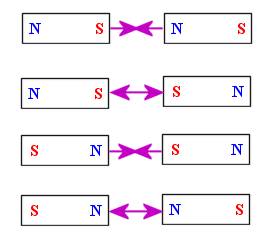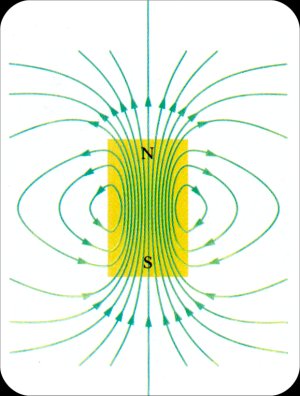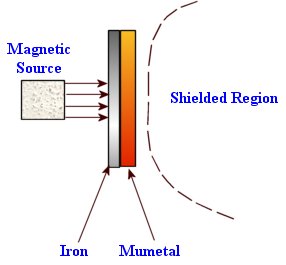
Laws of Magnetism
We have all experienced magnetism in some aspect of of lives and have some knowledge of its nature. We've all worked against magnets force of attraction when trying to open our refrigerator doors. Many of us have played with bar magnets and have learnt through experience that magnets have two poles - a North Pole and a South Pole. We've seen how like poles repel and unlike poles attract. Some have used magnets to deflect compass needles without realizing that the needle was itself a magnet trying to align its magnetic field with the field of the external magnet.
 |
|
Laws of Magnetism |
Magnetism owes its existence to moving charges. Electrons can be viewed as tiny spinning negative charges. This spinning motion gives rise to a spin magnetic moment. The spinning electron behaves like a magnetic dipole. Broadening our view we see that electrons orbit atomic nuclei. This motion creates an orbital magnetic moment.
What we commonly think of as magnetism is actually a special case called ferromagnetism ( shown by iron, cobalt and nickel). When exposed to an external magnetic field the unpaired electrons of the ferromagnetic material adjust to align their magnetic fields with the external source. Alignment on a large scale gives rise to the magnetic property. When the external magnetic field is removed these magnetically soft materials lose their magnetism.
Alloys of steel can be manufactured which retain magnetic properties after the external field is removed. Such materials are magnetically hard.
Materials are organized into domains which have a net magnetic field. These domains, however, are randomly aligned giving materials a zero net magnetic field. In ferromagnetic materials the domains are easily aligned by the application of external magnetic fields. Impurities in the material, for example carbon in the iron crystal makes magnetization more difficult to achieve (domain realignment difficult) . However, once such hard materials are magnetized they are not easily demagnetized.
 |
|
Magnetic Domains (no extrinsic magnetic field) |
There are other types of magnetic materials besides ferromagnetic materials, namely, paramagnetic and diamagnetic materials.
1st Transition Series:
Scandium, Titanium, Vanadium, Chromium, Manganese, Iron, Cobalt, Nickel, Copper.
The transition elements are metals which have unpaired electrons. This allows them to be paramagnetic - that is, they are weakly attracted to magnets. Many compounds of the transition elements are also paramagnetic.
Substances that contain only paired electrons are diamagnetic - that is, they are weakly repelled by magnets. This includes most non metals and their compounds.
Magnetic fields can be represented by Magnetic Field Lines. There are rules that are employed when drawing field lines.
Also, the field is strongest at the poles of a magnet.
 |
| Magnetic field of a Bar Magnet |
In electronics we use many devices that emit magnetic fields. The speaker and transformer are two such devices. Often other electronic components are affected by magnetic fields and we must find a way to shield them from extrinsic fields. For instance think of the effect of a magnet on a television display. Anyone who has brought a magnet near a TV screen knows that the image is distorted near the region of the magnet. The speakers in the TV and those placed near PC monitors are shielded to prevent this occurrence.
Shielding is achieved by separating the source of the field and the area to be protected by a highly permeable soft magnetic material. In this way the energy of the magnetic field is used in aligning the domains of the shield.
Mumetal is an alloy, composed of 76% Nickel, 17% Iron, 5% Copper and 2% Chromium, that is used for magnetic shielding because of its high permeability (and because it is magnetically soft).
If the extrinsic magnetic field is strong the shield is often made of a layer of iron and mumetal, the iron surface being closer to the magnetic source. This allows better shielding by reducing the possibility of magnetic saturation in the mumetal.
 |
|
Magnetic Shielding |